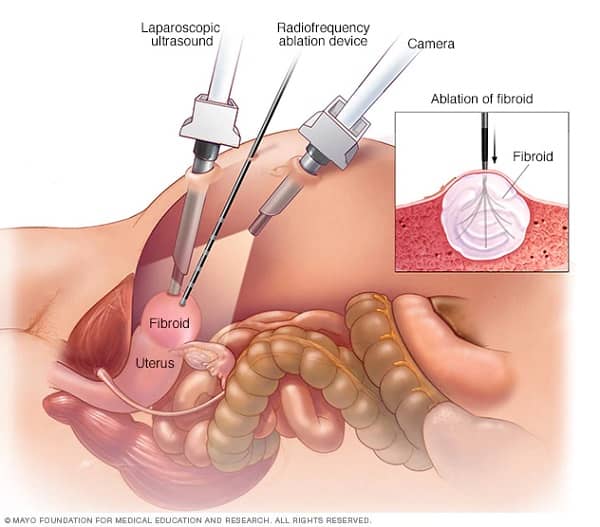


22 Jan What Causes Uterine Fibroids | Symptoms & Treatment Explained
The exact causes of uterine fibroids are not yet known for certain. Though, it can be the result of multiple biological factors interacting with each other. Being diagnosed with uterine fibroids is actually a nightmare for many middle-aged women and older ones alike. Although it seldom is a cause for concern, the symptoms, when present, are bothersome, to say the least.
In simple terms, uterine fibroids are noncancerous growth in or on uterus walls that causes symptoms in moderate to severe cases. These are usually made up of muscle and connective tissue from the walls of the uterus itself.
However, you can find solace in the fact that fibroids are rarely life-threatening and almost never develop into cancer.
What Causes Fibroids is dictated by a number of factors depending on a woman’s age, genes, and hormonal changes.
But as the causation and symptoms vary so much, there has to be a proper diagnosis to determine the best treatment options.
Find Out:
#1. The Possible Causes of Uterine Fibroids
#2. The Effects of Uterine Fibroids on Pregnancy
#3. Symptoms of Uterine Fibroids
#4. Diagnosis and Treatment of Uterine Fibroids
#5. How to Reduce the Risk of Uterine Fibroids?
#6. When to Worry About Uterine Fibroids?
What Causes Uterine Fibroids in Women?
In reality, the majority of women will have fibroids at some point in their life. The good news is most never experience any symptoms.
Uterine Fibroids are most common among women of childbearing age. So, women above the age of 30 can be at risk here.
A pelvic exam or prenatal ultrasound often helps you discover if you have uterine fibroids. In fact, some are so small that they are often undetectable by the naked eyes.
Though, in spite of their commonality among women these days, the causes of uterine fibroids are yet to have concrete data.
From what we’ve known so far, there can be a mix of factors at play here.
#1. Hormonal Fluctuations
Changes in hormones is a common thing when a woman goes through menstruation or through menopause.
Experts believe estrogen and progesterone are the two hormones to blame here.
Every month, when you get your periods, these hormones thicken the uterine lining. This is suspected to stimulate the growth of the fibroids.
#2. Genetic Risks
While your family history is completely beyond your control, this may increase your chances of having fibroids.
So, look out if your grandmother or your mother had the issue.
In fact, there have been observations of genetic differences in fibroids that differ from normal uterine cells.
Thus, your family’s medical history is something to take into account here.
#3. Extracellular Matrix (ECM)
ECM causes the cells to stick together and provide structural support. As it plays a key role in a number of cellular functions, normal cells also have ECM.
However, fibroids usually have more ECM than normal cells, which causes them to be fibrous in nature.
#4. Insulin-like Growth Factors
Insulin-like Growth Factors may affect the growth of the fibroids as they help in tissue upkeep.
Other substances that help the body maintain tissues may also affect fibroids growth.
#5. Deficiency of Certain Micronutrients
Malnourishment can also be one of the causes of fibroids growth. For instance, a deficiency of Vitamin D may be the culprit.
Thus, women should always pay special attention to have a rich diet that can balance out their nutritional needs.
#6. Chronic Stress
Yes, expect stress to take a toll on your health here as well. There have been studies that have linked major life events to the presence of uterine fibroids.
So, whatever you need to do to manage stress, do it! While some stress is obvious, long-term stressful situations can obviously cause damage.
#7. Pregnancy
There’s a reason why women of childbearing age are more likely to get fibroids. Pregnancy is one of the leading causes of uterine fibroids development.
The main Causes of Fibroid in Pregnancy is the overproduction of estrogen and progesterone. This causes the fibroids to grow.
After all, fibroids need hormones for growth.
Do Uterine Fibroids Interfere with Pregnancy?
No, not usually.

Fibroids are often harmless when it comes to your ability to get pregnant or carry out a pregnancy successfully.
However, there are exceptions.
The risk of fibroids interfering with pregnancy is greater in the case of submucosal fibroids.
They can also cause complications if fibroids are positioned where the baby needs to be.
In some cases, uterine fibroids can even cause infertility or issues like fetal growth restriction and preterm delivery.
That’s why a proper diagnosis of the size and location of these benign tumors is crucial. However, before that, you need to recognize the first signs and Symptoms of Fibroids.
What are the Symptoms of Fibroids?
Most fibroids do not cause any symptoms. These are usually small and asymptomatic in nature. Thus, you might not need any treatment in this case.
However, Fibroids Symptom primarily depends on the location, size, and type of growth.
For instance, submucosal fibroids form in the middle muscle layer and may cause trouble in conceiving.
Likewise, subserosal fibroids form on the outside of the uterus. These may make the womb appear bigger on one side when large enough.
Women typically experience these Signs of Uterine Fibroids.
- Heavy menstrual bleeding with blood clots
- Prolonged periods lasting for more days than usual
- Spotting between periods
- Pain in the pelvic area or pelvic pressure
- The feeling of pressure or fullness in the lower abdomen
- Increase in urination
- Constipation
- Pain during intercourse
- Unusual swelling or bloating of the abdomen causing you to look pregnant
- Acute pain in the lower back
Moreover, the Symptoms of Fibroids will also vary depending on whether you are menopausal or not.
Women during their menopause may find that their fibroids shrink on their own due to hormonal changes.
If you’ve been noticing multiple signs, your best bet is to get yourself checked ASAP.
Your doctor would be able to diagnose and estimate what may be the causes of uterine fibroids in your case.
While you may not be able to know the causes of uterine fibroids for certain, diagnosing the symptoms is certainly possible.
Uterine Fibroids: Diagnosis and Treatment



Your gynecologist might find uterine fibroids during a routine pelvic exam. After that, there can be further tests to confirm the presence of fibroids.
These tests may include ultrasound, MRI, Hysterosonography, Hysterosalpingography, Hysteroscopy, or other blood tests to assess the causes of uterine fibroids.
Blood tests also help figure out if you’ve anemia or other bleeding disorders due to fibroids.
Uterine Fibroids Treatment Options
The Best Treatment for Fibroids will depend on the severity of your symptoms and whether you’re actually having them.
Moreover, your doctor may also recommend a specific treatment option depending on your age and fibroids’ location.
#1. Dietary Changes and Home Remedies for Mild to No Symptoms
In cases where your fibroids are too small to cause any symptoms, your doctor might wait and see if they shrink on their own.
In fact, most fibroids do shrink on their own or may not grow any further.
Your doctor may recommend making some changes in your lifestyle like exercising and managing stress.
Making dietary changes can help minimize the risk factors of uterine fibroids.
You might also benefit from losing weight if you’re overweight.
#2. Medications for Moderate Symptoms
There are some medications that can help address pain and bleeding from fibroids.
Your doctor may prescribe anti-inflammatory pain relievers and birth control pills for that. Though, these won’t necessarily help shrink the uterine fibroids.
On the other hand, medications like Gonadotropin-releasing hormone (GnRH) agonists will block the production of estrogen and progesterone. This helps shrink fibroids by suppressing menstruation.
There are also medications for days you’re bleeding heavily to control the flow.
However, if your symptoms are beyond the scope of natural remedies and medication, the last resort is…
#3. Surgery for Severe Symptoms
Surgery is often performed to remove large or multiple growths of uterine fibroids.
Common surgery options include:
- Abdominal Myomectomy: This involves taking out the fibroids by making a large incision in the abdomen. Another way to do a myomectomy is also through laparoscopy.
- Uterine Fibroid Embolization: This procedure typically involves blocking the flow of blood to the fibroids and making them shrink.
- Endometrial Ablation: This is a comparatively less invasive procedure. It entails inserting special equipment into your uterus and using electric current, hot water, or extreme cold to destroy the uterine lining.
- Hysterectomy: It involves complete removal of the uterus. However, Hysterectomy is often the last resort when all the other treatments are not possible.
Most women who wish to get pregnant in the future opt for a myomectomy. Though, the right treatment plan for you is only possible after a complete assessment from a healthcare professional.
Of course, nobody wants to go through surgery. And you don’t have to, in fact. Fibroids are rarely this serious for you to have surgery.
Still, the uncertainty around the causes of uterine fibroids begs the question: Can You Prevent Fibroids in the first place?
Can You Prevent Uterine Fibroids?
While it may not be possible to prevent the condition, there are ways to reduce the risk factors.
While researchers continue to figure out the causes of uterine fibroids, some lifestyle changes can help reduce the risk.
After all, you can only control what’s in your hand. Factors like the early onset of menstruation or genetics can’t be changed, but you can take measures to modify your diet.
There is some evidence that eating fruits and cruciferous vegetables may help lower the risk of fibroids.
Nonetheless, it goes without saying that you need to manage your workload and stress levels.
- Include more fruits and green vegetables like broccoli, cabbage, arugula, cauliflower, and collard greens in your diet
- Minimize sugar intake
- Abstain from a diet high in red meat
- Maintain a vitamin, minerals, and fiber-rich diet
- Incorporate regular exercise into your routine (Try aerobics to reduce visceral fat and keep hormones in check). Regular exercise also lowers estrogen levels.
- Decrease the consumption of alcohol
- Maintain a normal weight
When to Worry About Uterine Fibroids?
Some cases may present challenging symptoms that require medical attention. If you experience any discomfort or symptoms, it’s best to not sweep it under the rug.
There are treatments available that can drastically improve symptoms and relieve your discomfort.
Pregnant women with fibroids should take extra care and talk to their doctor about their treatment options. It’s very much possible to get pregnant without interference from the fibroids.
You just need to be aware of your symptoms and condition at all times and update your doctor about the same.
Having said that, up to 40 to 80 percent of women can have fibroids by the age of 50.
Most of them may never know they have fibroids because of no symptoms.
But from the looks of it, the thought of getting uterine fibroids may make you anxious. But remember, it’s something many women experience during their lifetime.
Most small fibroids do not cause any symptoms. Furthermore, they can shrink on their own, especially after menopause due to hormonal shifts.
Continue to eat healthily and stay active. With more data on the causes of uterine fibroids, we can expect more avenues for prevention and treatment plans in the future.
[isc_list]



No Comments